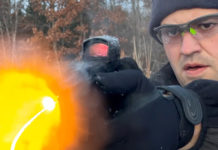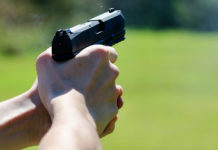
On January 19, 2017, Sig Sauer was awarded the new US Army Modular Handgun System contract. The XM 17 was meant to replace the Beretta M9 and the Sig M11 used by the Army and the Air Force.
The US Army’s main requirements were reliability, accuracy, and effectiveness. The other needs included a weapon system with more features like a non-caliber-specific firearm, an accessory rail, the ability to mount a suppressor, and adaptation for various hand sizes. The vast majority of handguns are used by the various special forces groups, who put more wear and tear on their handguns and need more adaptability. Many groups had already replaced their M9s with guns like Glocks, other Sigs, and modern versions of the M1911. Designated the XM17 by the US Army, this new gun was based on the popular P320 line of handguns by Sig, which allowed the end user a high degree of change to suit the shape and style of the shooter.
The main difference between the military and civilian versions is the XM17 comes configured to accept a suppressor. The civilian version does not come with this standard. The civilian version of this gun is the M17 P320 and M18 P320, with the difference being the M18 has a shorter barrel.
A while back, I had a chance to put my hands on both and decided I wanted one. I had been toying with the idea of replacing my XM9 with a new full-size 9 for competition and range day shooting. Once I held the M17, the toying was over. I bought the M17 and cannot be happier with my purchase.
Red dots for pistols have become a big thing in the shooting world, but I’m old school and stubborn. I decided with this gun; I’d delve into this arena. I purchased a Sig Romeo 1 Pro red dot and installed it. I’ve had both for several months now and wanted to share my thoughts with you.
The Gun
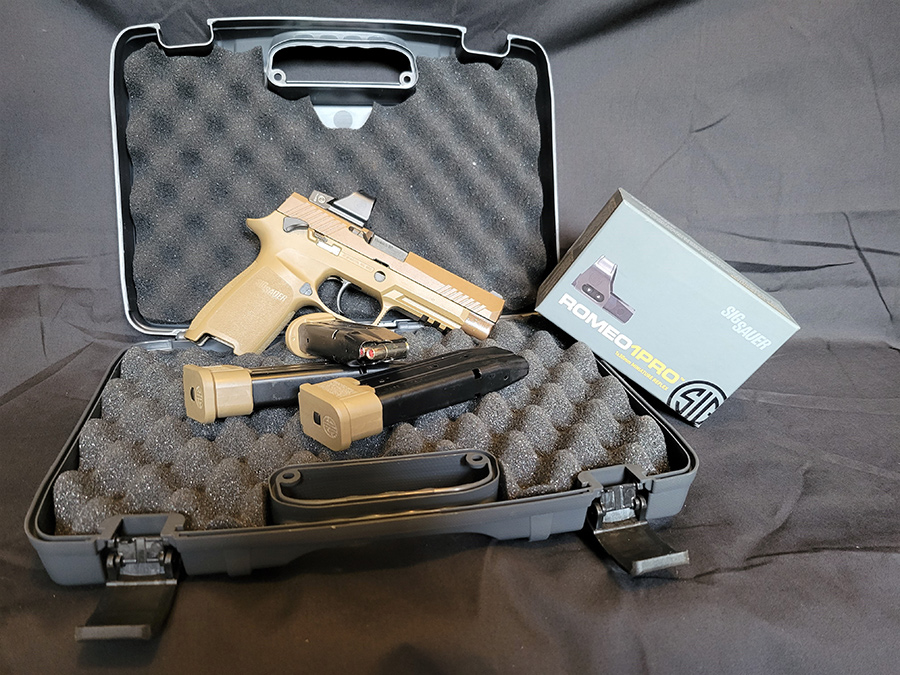
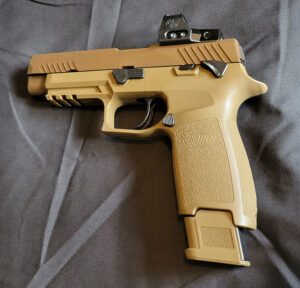 The gun itself felt great in my hand and points instinctually. I prefer a longer sight radius and longer barrel and slide, so I went with the M17. Although the M18 felt a bit better balanced in hand, I couldn’t get past the easier time I had acquiring the sights on the M17. The M17 weighs in at 29.4 oz, and the M18 is 26 oz., meaning there isn’t a huge weight difference between the 2. They both come standard with SIGLITE tritium front and rear night sights along a slide piece cut to accept aftermarket red dot sights. They also come with an ambidextrous manual safety, ambidextrous slide stop, a 17 round plus two 21 round magazines. The M18 barrel length is 3.9,” and the M17 has a 4.7″ barrel. The height and width are the same on both guns, with the height being 5.5″ and the width at 1.4″.
The gun itself felt great in my hand and points instinctually. I prefer a longer sight radius and longer barrel and slide, so I went with the M17. Although the M18 felt a bit better balanced in hand, I couldn’t get past the easier time I had acquiring the sights on the M17. The M17 weighs in at 29.4 oz, and the M18 is 26 oz., meaning there isn’t a huge weight difference between the 2. They both come standard with SIGLITE tritium front and rear night sights along a slide piece cut to accept aftermarket red dot sights. They also come with an ambidextrous manual safety, ambidextrous slide stop, a 17 round plus two 21 round magazines. The M18 barrel length is 3.9,” and the M17 has a 4.7″ barrel. The height and width are the same on both guns, with the height being 5.5″ and the width at 1.4″.
Those are the facts and figures on the gun, but what really matters are feel and performance. I can’t say it enough; the M17 feels good. The grip is in the sweet spot for me of not too big or not too small. That sells me on a gun faster than any review, so go out and hold one. See if it does the same for you. As I stated before, it is an instinctive pointer. Meaning when I pull the gun up to my eye in a standard isosceles stance, I can see both sights clearly and get on target in an instant. This is important in competition shooting because second’s count.
The same could be said for a defensive situation in life, so I look for that aspect in everything I buy. The trigger pull is clear and smooth with a crisp solid break and very little reset. I will note here that the curvature of the trigger blade may be a bit too extreme for my liking. Sig states it is a standard curve, but I still feel my finger drift down as I shoot. This causes me to index the trigger with the wrong part of my finger pushing my shots a bit left. I’ve been thinking about replacing it with a flat bow trigger since I tend to index them better. However, I have not made this purchase yet. This, of course, is a personal preference point and one of the joys of this gun. You have the option of changing triggers without a whole lot of fuss. The slide is machined from stainless steel coated with PVD in coyote tan. The controls are placed well with easy access on the run. I did notice the usual amount of stiffness in the safety right out of the box, but that did loosen with time. The mags are aluminum with a stainless-steel spring and plastic follower and baseplate. They load easily and balance the longer barrel nicely, especially with the 21-round mag.
Range Day
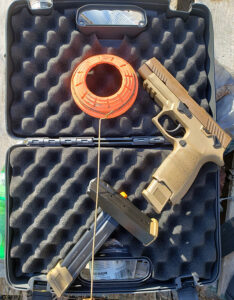 The accuracy was impressive. The first day I went out to my range and set up a few ground-level clay holders along with my trusty paper plate target to see just what I bought. Ammo prices and availability being what they are, I didn’t shoot a whole lot. Mostly I did ten rounds in a mag to test accuracy and function. I like to first shoot from a bench to see the gun’s best capabilities, and then I shoot freehand to see my capabilities with the gun. Of course, the group opens up a bit when I stand, but the question becomes, how much.
The accuracy was impressive. The first day I went out to my range and set up a few ground-level clay holders along with my trusty paper plate target to see just what I bought. Ammo prices and availability being what they are, I didn’t shoot a whole lot. Mostly I did ten rounds in a mag to test accuracy and function. I like to first shoot from a bench to see the gun’s best capabilities, and then I shoot freehand to see my capabilities with the gun. Of course, the group opens up a bit when I stand, but the question becomes, how much.
I want to say we fit well together because it wasn’t a lot. From 10 yards at the bench, my best ten-shot group was holding within a few inches with quite a few touching. Freehand, I shot a similar group of a few inches but not any touching. Unfortunately, I recently cleaned my office and accidentally threw away my targets before getting definitive measurements. However, the pictures show what I saw. Both are more than capable of getting the job done and keeping me from being embarrassed at my next match or range day. I made the mistake of not taking a picture of the ammo I was shooting that day but rest assured, it wasn’t anything fancy or special loaded. I can’t afford that stuff—just regular old range ammo. I did decide to add a few reload drills in the mix and even bullseye a few clays on the ground. Overall, accuracy is awesome, and I love shooting this gun. So much so it has also become my bedside gun and sidearm out on my land. That’s one check box the Army can mark off.

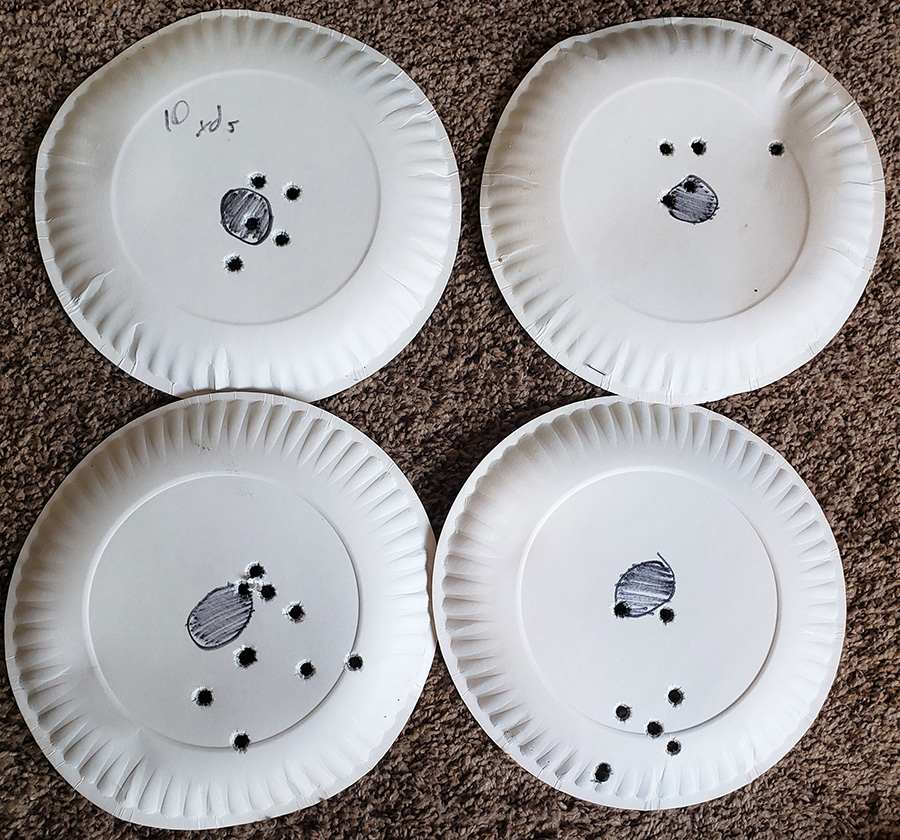
Reliability is what you’d expect to come from a Sig. I shot standard range ammo, including aluminum case but not steel, and had zero issues. Since my first range day, I’ve carried this gun to cut and split firewood, plant and fertilizer fields, mow and trim the yard, and a ton of other outdoor chores associated with owning a larger amount of land in the mountains, and this gun has been on my side. It has never once failed, and with mud, water, sweat, sawdust, and everything else literally thrown on it, the red dot never once faltered either.
The Red Dot
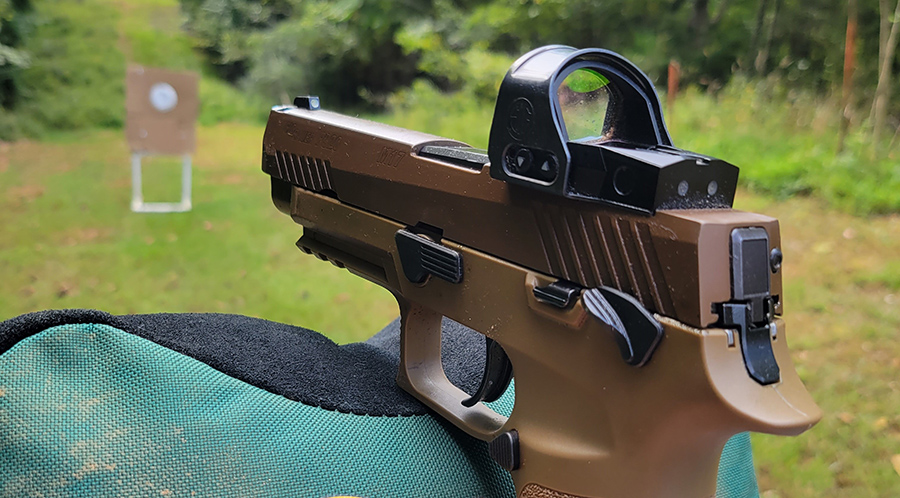
I decided to join the red dot handgun crowd and see what all the fuss was about. I ordered the Sig Romeo 1 Pro for two main reasons. The first is that the red dot is made specifically to fit the gun, and secondly, the auto on/off feature appealed to me. The other red dot stated to be a direct fit is the Leupold Deltapoint Pro. If there is another manufacturer you prefer, an Adapter plate will be required.
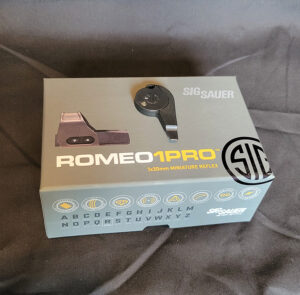 The Sig Romeo 1 Pro is a 3 MOA red dot reflex sight. It weighs only 1 oz, sits at 27.4mm high, is 31.7mm wide, and is 46.5mm long. It is a perfect fit for the pistol slide and, with the lightweight, doesn’t affect the feel and balance of the gun. It has ten brightness levels that adjust via the raised button found on the left side of the optic. It also comes with a shroud to protect them from being accidentally indexed from a bump. The adjustments are made via two scope style adjustment wheels found on the top and side of the optic and are done in 1 MOA increments. One critique I would make here is I would like an audible click when the adjustment is made. Currently, my model does not do this, so I have to memorize the line I’m on before counting my adjustments, and with my eyesight failing at close objects, this can be difficult. The optic comes with a convenient keychain tool that allows for easy adjustments and houses a spare CR1632 battery. Run time is listed at 20,000 hours, and with the motion-activated on/off feature, I’d say you can expect to get pretty darn close to that, depending on which brightness level you leave it on. Any motion will instantly turn on the red dot, including just a touch, and I timed the shut-off at 1 minute and 55 seconds. It also has IPX 7 waterproofing (which works in the rain and with pond water being splashed on it, I can attest to this), and the 30mm objective lens lets in a lot of light, even when dirty.
The Sig Romeo 1 Pro is a 3 MOA red dot reflex sight. It weighs only 1 oz, sits at 27.4mm high, is 31.7mm wide, and is 46.5mm long. It is a perfect fit for the pistol slide and, with the lightweight, doesn’t affect the feel and balance of the gun. It has ten brightness levels that adjust via the raised button found on the left side of the optic. It also comes with a shroud to protect them from being accidentally indexed from a bump. The adjustments are made via two scope style adjustment wheels found on the top and side of the optic and are done in 1 MOA increments. One critique I would make here is I would like an audible click when the adjustment is made. Currently, my model does not do this, so I have to memorize the line I’m on before counting my adjustments, and with my eyesight failing at close objects, this can be difficult. The optic comes with a convenient keychain tool that allows for easy adjustments and houses a spare CR1632 battery. Run time is listed at 20,000 hours, and with the motion-activated on/off feature, I’d say you can expect to get pretty darn close to that, depending on which brightness level you leave it on. Any motion will instantly turn on the red dot, including just a touch, and I timed the shut-off at 1 minute and 55 seconds. It also has IPX 7 waterproofing (which works in the rain and with pond water being splashed on it, I can attest to this), and the 30mm objective lens lets in a lot of light, even when dirty.
Installation was straightforward; of course, that’s what happens when you get the right parts. The instructions weren’t the clearest, so I watched a YouTube video, which made things worse. It’s funny how the gun in those videos usually has one or two small things different from what you are holding, and they show little tricks that might make it easier for them but don’t always translate to you. However, between the two, a light came on, and I realized I was overthinking it, as usual. Once installed, I began having fun and problems.
Range Day
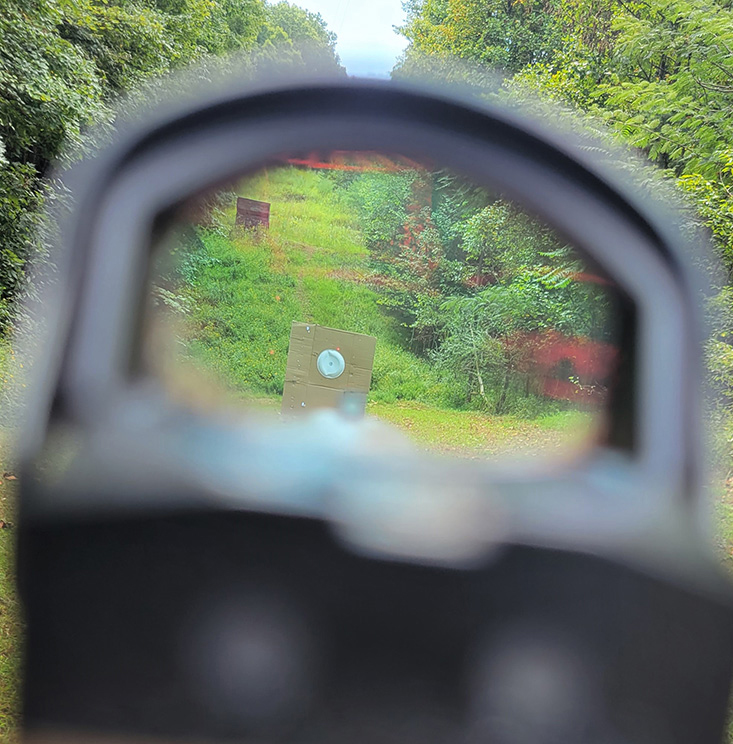
I’ve sighted in scopes and red dots on all things that go bang along with multiple crossbows. I’ve replaced and sighted in new sights for an assortment of handguns, including laser sights and adjustable rear sights on target pistols. However, this was different. The normal sighting technique taught to pistol shooters rely heavily on you seeing and focusing on the front sight; after all, that’s the end the bullet leaves. However, this eliminates seeing the front sight and is a floating red dot at the rear of the gun. I was able to chase it around enough from the bench to get it grouping pretty good slightly off-center. As I was initially debating this purchase, I spoke to one of the older guys I work with about his red dot pistol, and he raved, “It’s like cheating. It’s so easy. Do it. You’ll love it.” After a frustrating range session, I told him (with some less than friendly passion), “The opposite you said!” I was honestly wondering if I forgot how to shoot. He started laughing and asked one simple question, “Did you focus on the red dot?” Well, of course, I did. That’s what I’ve been taught. Focus on the sight. He told me to go back to the range, look at the target, make that your focus and shoot when the red dot covers it. Excuse the country lingo, but “I’ll be dipped.” He was right. Not only was I hitting the target but quicker and more consistently. I know red dots are for quick target acquisition, not accuracy, but for some reason, when it came to a handgun, my mind couldn’t make that transition. I don’t know why but it couldn’t. I was so frustrated I almost took the red dot off and sold it since I was shooting better with the iron sights.
Now that I have that figured out, I’m loving it. I still need some range time to build better muscle memory, but overall, I see the benefits of it. As far as accuracy with the red dot goes, it’s impressive. I tested three different rounds I had on hand and did three 5-shot groups with each. Below is a graph with the results.
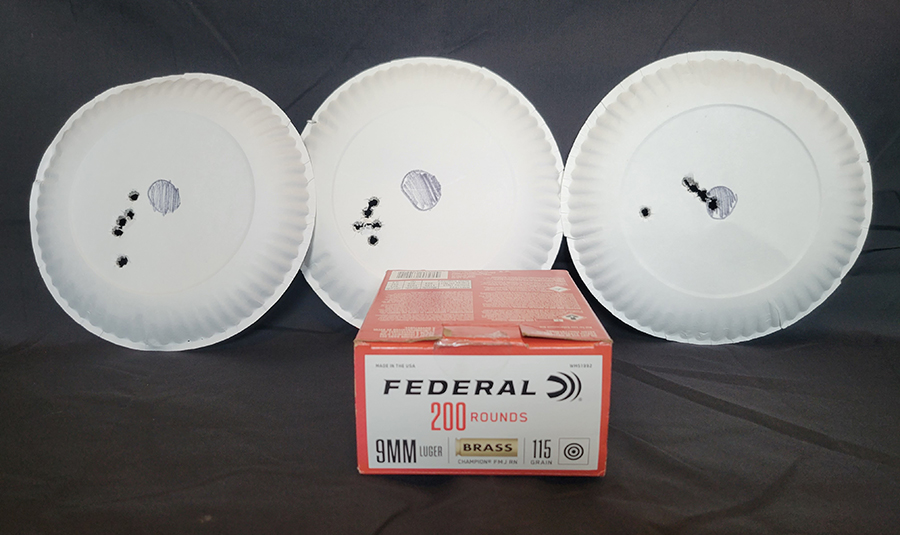
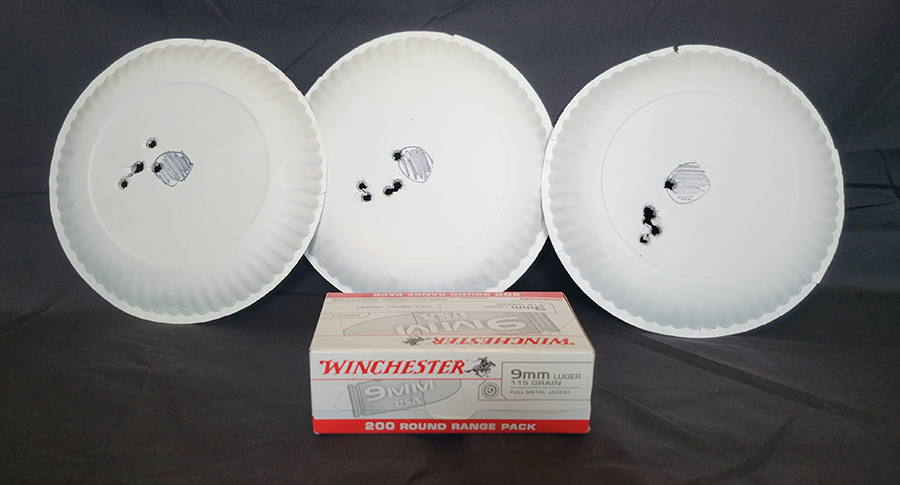
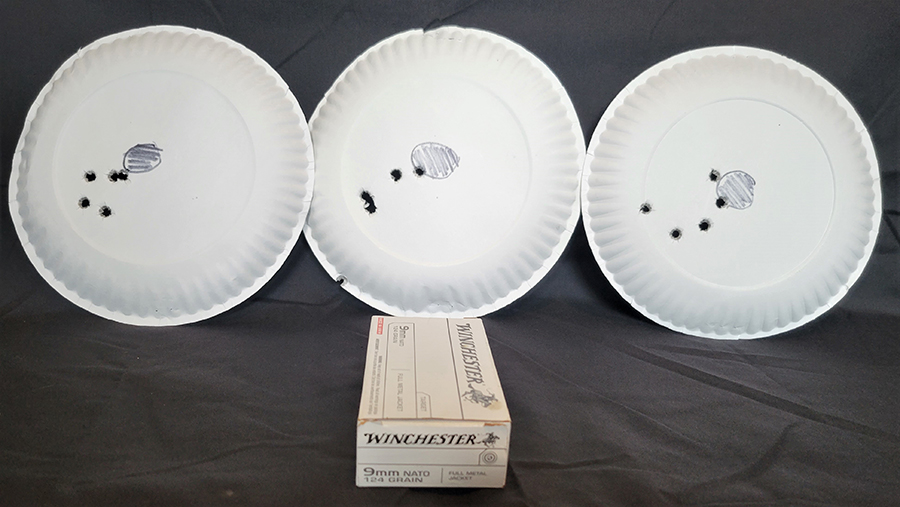
|
Ammo |
Best Group |
Group Average |
|
Winchester 115 Grain |
1.5” |
1.58 |
|
Winchester 124 Grain |
1.125” |
1.375” |
|
Federal 115 Grain |
1.125” |
1.625” |
As you can see, all shot well, with the best average being the Winchester 124 grain NATO and the most consistent being the old Winchester White Box. These shots were taken from a bench at 10 yards. Once my range session was done, I shot around 50 rounds, and there was a ragged hole in the target backer.
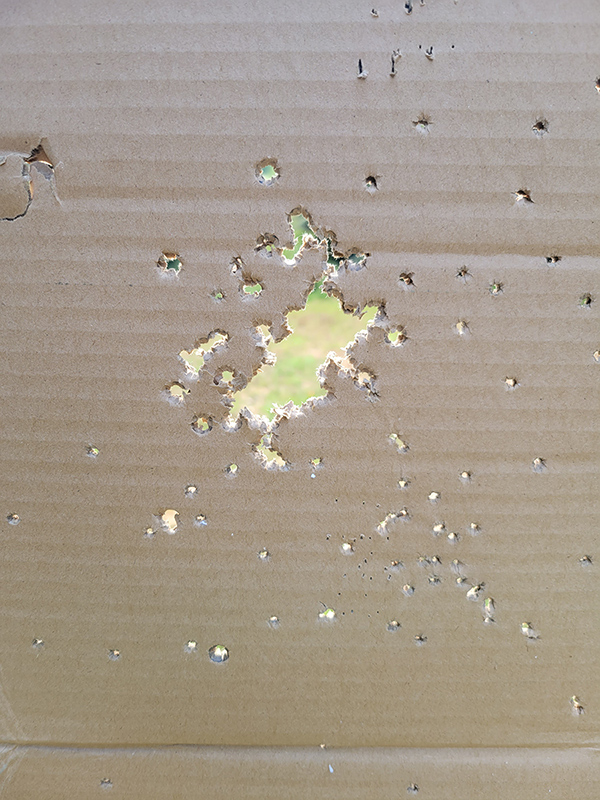
I will caution, though, as an instructor, I see the harm in teaching a new or first-time shooter to shoot with a red dot. It will make learning Iron sights, after the fact, harder, and with a majority of popular handguns do not come standard with this capability. I can see it hamper a new shooter’s growth and progress by making the expectations too simple. That’s just my suspicion and 2 cents of opinion for what it’s worth.
Recently had a range day with friends, and we set up a quick 3-gun course. I truly saw the benefits of the red dot then. I was able to speed my time up, making me more confident in my shots. While I am not a professional shooter by any stretch, I got to test the real-world application of a red dot and was sold on its effectiveness. Overall, an excellent investment.
Conclusion
Retail for this gun runs around $679, a quick search on the internet brought up that price at Sportsmans Warehouse. For everything you get, I’d say it’s worth every penny. With it being built on the 320 platform, you also have a ton of options for customizing the gun to better fit you. The serialized part is a parts module inside the frame so that you can change every component from the slide, barrel, caliber, frame, and everything in between. Although I’m good with everything as is, I do have an itch to change the trigger. I know many people jump on a bandwagon; if it is military, then it’s awesome. Sometimes this is true; in this case, I’d say it is certain, but I’m not usually that guy. I buy what I like, and this gun felt good from the first moment I held it. If you can find it and can afford it, I suggest picking one up. I promise you won’t regret it. It is everything you’d expect out of a Sig.

Be sure to read more in our blog section.
Want more posts like this one? Subscribe to Guns & Tactics to receive email updates and special offers direct to your inbox!
Social Links:
– The views and opinions expressed on this web site are solely those of the original authors and contributors. These views and opinions do not necessarily represent those of Guns & Tactics, the administrative staff, and/or any/all contributors to this site.
– Affiliate Disclaimer: Guns and Tactics is reader/viewer supported. This post may contain affiliate links and we may earn a small commission when you click on the links at no additional cost to you. As an Amazon Affiliate I earn from qualifying purchases.



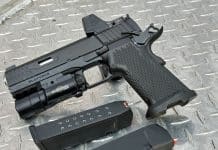
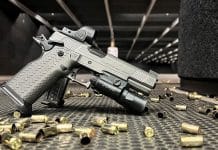

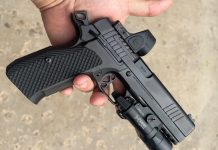
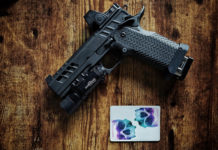
![Holosun 507 Comp Review [Video] Holosun-507-Comp-Review](https://www.gunsandtactics.com/wp-content/uploads/2023/07/Holosun-507-Comp-Review-218x150.jpg)
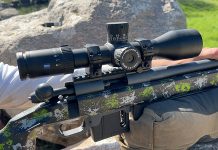
![Holosun 509T Review [Hands-On] Holosun-509T-Review](https://www.gunsandtactics.com/wp-content/uploads/2022/12/Holosun-509T-Review-218x150.jpg)
